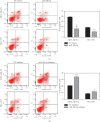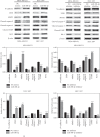Mir-30b-5p Promotes Proliferation, Migration, and Invasion of Breast Cancer Cells via Targeting ASPP2
- PMID: 32420372
- PMCID: PMC7210518
- DOI: 10.1155/2020/7907269
Mir-30b-5p Promotes Proliferation, Migration, and Invasion of Breast Cancer Cells via Targeting ASPP2
Abstract
Triple-negative breast cancer (TNBC) is the most aggressive subtypes of breast cancer, which has few effective targeted therapies. Various sources of evidence confirm that microRNAs (miRNAs) contribute to the progression and metastasis of human breast cancer. However, the molecular mechanisms underlying the changes in miRNAs expression and the regulation of miRNAs functions have not been well clarified. In this study, we found that the expression of miR-30b-5p was upregulated in breast cancer tissues and breast cancer cell lines, compared to paracancer tissues and normal breast cell lines. Moreover, induced overexpression of miR-30b-5p promoted the MDA-MB-231 and HCC 1937 cell growth, migration, and invasion and reduced the cellular apoptosis. Further studies confirmed that miR-30b-5p could directly target ASPP2 and then activate the AKT signaling pathway. Our results suggested that miR-30b-5p could act as a tumor promoter in TNBC. The newly identified miR-30b-5p/ASPP2/AKT axis represents a novel therapeutic strategy for treating TNBC.
Copyright © 2020 Tianqi Wu et al.
Conflict of interest statement
The authors declare no conflicts of interest.
Figures







References
Publication types
MeSH terms
Substances
LinkOut - more resources
Full Text Sources
Medical
Miscellaneous

